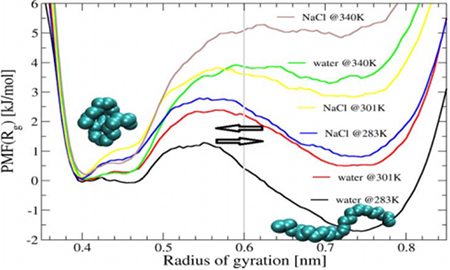Dr. Jan Heyda, Helmholtz Zentrum Berlin
The so called partitioning concept established recently by Tom Record provides an successful model, which can predict melting temperature changes in protein denaturation, or DNA unwinding. Employing molecular dynamics simulations, we will probe this model with the simplest thinkable model – hydrophobic homopolymer C25. C25 exhibits 2-state behavior; it is swollen below Tcrit and collapsed above it (compare water at 283K, 301K, 340K). The addition of salt has an effect on energetics of these two states (see the figure below), which leads to the increase or decrease of the Tcrit. This effect is strongly salt specific. The thermodynamics of C25 is calculated directly from replica-exchange MD, while the ion partitioning on methane-surface (model compound for hydrophobic C25) is obtained by wide spectrum of free energy methods. Their (dis-)advantages will be discussed.

Finally let us note that this is a first step in the direction towards the manipulation of the Tcrit of thermoresponsive polymers by salt . Examples, such as PNIPAM, or poly-ethylene-oxide, are key-part of smart materials which functional properties can be easily tuned by small changes in the environment.
Time & Location
May 16, 2013 | 04:15 PM
Seminar Room T2 (1.4.03)